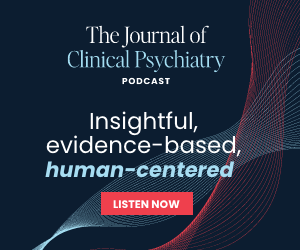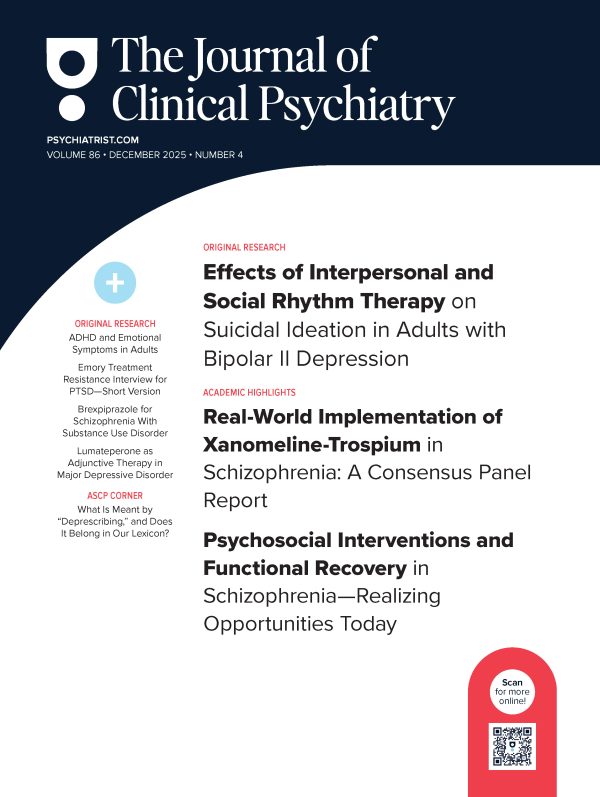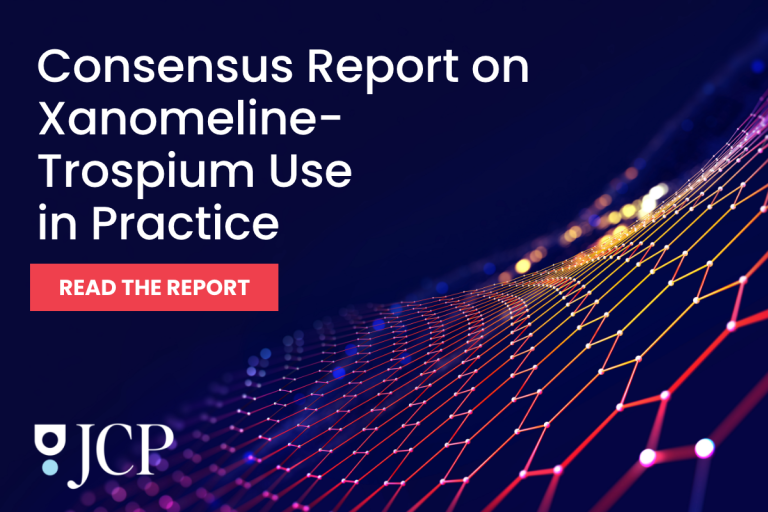ABSTRACT
Objective: The aim of this study was to examine satisfaction with pharmacologic treatment in patients who received antipsychotic polypharmacy compared to antipsychotic monotherapy.
Methods: This longitudinal cohort study was conducted in two mental health care institutes in Amsterdam, the Netherlands, among a randomly selected sample of in- and outpatients with a severe mental illness. Analyses were performed on data collected in 2011 for 185 patients who were diagnosed with schizophrenia or unspecified psychosis according to DSM-IV criteria. The outcome measure was the Treatment Satisfaction Questionnaire for Medication, version II. One-way analyses of covariance were performed to examine differences in treatment satisfaction between patients who received antipsychotic polypharmacy compared to antipsychotic monotherapy while controlling for the effects of clozapine, antipsychotic dose, and use of long-acting injectable antipsychotics.
Results: Twenty percent of patients in this sample received 2 antipsychotic agents; in half of those patients, this involved a combination with clozapine. Polypharmacy resulted in less satisfaction with side effects compared to monotherapy (P = .002). No difference was found in perceived effectiveness (P = .168) or overall medication satisfaction (P = .379).
Conclusions: These results confirm that antipsychotic polypharmacy is common in a random in- and outpatient sample. Patients who receive 2 antipsychotic agents are just as positive about the effectiveness and ease of use of and overall satisfaction with their medication compared to those who receive antipsychotic monotherapy. They are, however, less satisfied with perceived side effects of their medication, which may indicate that side effect profiles of antipsychotic combinations are less favorable.
Members Only Content
This full article is available exclusively to Professional tier members. Subscribe now to unlock the HTML version and gain unlimited access to our entire library plus all PDFs. If you’re already a subscriber, please log in below to continue reading.
References (40)

- Kane JM, Agid O, Baldwin ML, et al. Clinical guidance on the identification and management of treatment-resistant schizophrenia. J Clin Psychiatry. 2019;80(2):18com12123. PubMed CrossRef
- Correll CU, Shaikh L, Gallego JA, et al. Antipsychotic polypharmacy: a survey study of prescriber attitudes, knowledge and behavior. Schizophr Res. 2011;131(1-3):58–62. PubMed CrossRef
- Correll CU, Rummel-Kluge C, Corves C, et al. Antipsychotic combinations vs monotherapy in schizophrenia: a meta-analysis of randomized controlled trials. Schizophr Bull. 2009;35(2):443–457. PubMed CrossRef
- Fleischhacker WW, Uchida H. Critical review of antipsychotic polypharmacy in the treatment of schizophrenia. Int J Neuropsychopharmacol. 2014;17(7):1083–1093. PubMed CrossRef
- Gallego JA, Nielsen J, De Hert M, et al. Safety and tolerability of antipsychotic polypharmacy. Expert Opin Drug Saf. 2012;11(4):527–542. PubMed CrossRef
- Correll CU, Gallego JA. Antipsychotic polypharmacy: a comprehensive evaluation of relevant correlates of a long-standing clinical practice. Psychiatr Clin North Am. 2012;35(3):661–681. PubMed CrossRef
- Ganguly R, Kotzan JA, Miller LS, et al. Prevalence, trends, and factors associated with antipsychotic polypharmacy among Medicaid-eligible schizophrenia patients, 1998-2000. J Clin Psychiatry. 2004;65(10):1377–1388. PubMed CrossRef
- Lin SK. Antipsychotic polypharmacy: a dirty little secret or a fashion? Int J Neuropsychopharmacol. 2020;23(2):125–131. PubMed CrossRef
- Guinart D, Correll CU. Antipsychotic polypharmacy in schizophrenia: why not? J Clin Psychiatry. 2020;81(3):19ac13118. PubMed CrossRef
- Galling B, Roldán A, Hagi K, et al. Antipsychotic augmentation vs monotherapy in schizophrenia: systematic review, meta-analysis and meta-regression analysis. World Psychiatry. 2017;16(1):77–89. PubMed CrossRef
- Taylor DM, Smith L, Gee SH, et al. Augmentation of clozapine with a second antipsychotic—a meta-analysis. Acta Psychiatr Scand. 2012;125(1):15–24. PubMed CrossRef
- Tiihonen J, Taipale H, Mehtälä J, et al. Association of antipsychotic polypharmacy vs monotherapy with psychiatric rehospitalization among adults with schizophrenia. JAMA Psychiatry. 2019;76(5):499–507. PubMed CrossRef
- Carnahan RM, Lund BC, Perry PJ, et al. Increased risk of extrapyramidal side-effect treatment associated with atypical antipsychotic polytherapy. Acta Psychiatr Scand. 2006;113(2):135–141. PubMed CrossRef
- Correll CU, Frederickson AM, Kane JM, et al. Does antipsychotic polypharmacy increase the risk for metabolic syndrome? Schizophr Res. 2007;89(1-3):91–100. PubMed CrossRef
- Chakos MH, Glick ID, Miller AL, et al. Baseline use of concomitant psychotropic medications to treat schizophrenia in the CATIE trial. Psychiatr Serv. 2006;57(8):1094–1101. PubMed CrossRef
- Hori H, Noguchi H, Hashimoto R, et al. Antipsychotic medication and cognitive function in schizophrenia. Schizophr Res. 2006;86(1-3):138–146. PubMed CrossRef
- Fenton WS, Blyler CR, Heinssen RK. Determinants of medication compliance in schizophrenia: empirical and clinical findings. Schizophr Bull. 1997;23(4):637–651. PubMed CrossRef
- Katona L, Czobor P, Bitter I. Real-world effectiveness of antipsychotic monotherapy vs polypharmacy in schizophrenia: to switch or to combine? a nationwide study in Hungary. Schizophr Res. 2014;152(1):246–254. PubMed CrossRef
- Joukamaa M, Heliövaara M, Knekt P, et al. Schizophrenia, neuroleptic medication and mortality. Br J Psychiatry. 2006;188(2):122–127. PubMed CrossRef
- Waddington JL, Youssef HA, Kinsella A. Mortality in schizophrenia: antipsychotic polypharmacy and absence of adjunctive anticholinergics over the course of a 10-year prospective study. Br J Psychiatry. 1998;173(4):325–329. PubMed CrossRef
- Ijaz S, Bolea B, Davies S, et al. Antipsychotic polypharmacy and metabolic syndrome in schizophrenia: a review of systematic reviews. BMC Psychiatry. 2018;18(1):275. PubMed CrossRef
- Matsui K, Tokumasu T, Takekita Y, et al. Switching to antipsychotic monotherapy vs staying on antipsychotic polypharmacy in schizophrenia: a systematic review and meta-analysis. Schizophr Res. 2019;209:50–57. PubMed CrossRef
- Sommer IE, Begemann MJ, Temmerman A, et al. Pharmacological augmentation strategies for schizophrenia patients with insufficient response to clozapine: a quantitative literature review. Schizophr Bull. 2012;38(5):1003–1011. PubMed CrossRef
- Kroken RA, Johnsen E. Is rational antipsychotic polytherapy feasible? a selective review. Curr Psychiatry Rep. 2012;14(3):244–251. PubMed CrossRef
- Ortiz-Orendain J, Castiello-de Obeso S, Colunga-Lozano L, et al. Antipsychotic combinations for schizophrenia. Schizophr Bull. 2018;44(1):15–17. PubMed CrossRef
- Barbui C, Signoretti A, Mulè S, et al. Does the addition of a second antipsychotic drug improve clozapine treatment? Schizophr Bull. 2009;35(2):458–468. PubMed CrossRef
- Van Eck RM, Burger TJ, Vellinga A, et al. The relationship between clinical and personal recovery in patients with schizophrenia spectrum disorders: a systematic review and meta-analysis. Schizophr Bull. 2018;44(3):631–642. PubMed CrossRef
- Kikkert MJ, Dekker J. Medication adherence decisions in patients with schizophrenia. Prim Care Companion CNS Disord. 2017;19(6):17n02182. PubMed CrossRef
- Li Q, Xiang YT, Su YA, et al. Antipsychotic polypharmacy in schizophrenia patients in China and its association with treatment satisfaction and quality of life: findings of the third national survey on use of psychotropic medications in China. Aust N Z J Psychiatry. 2015;49(2):129–136. PubMed CrossRef
- Theunissen J, Duurkoop P, Kikkert M, et al. Na de extramuralisering. II. Een crosssectionele studie naar psychisch en social functioneren en kwaliteit van leven van een steekproef van chronische psychiatrische patiënten in de Amsterdamse ggz. Tijdschr Psychiatr. 2013;55:153–163.
- Nosè M, Tansella M, Thornicroft G, et al. Is the Defined Daily Dose system a reliable tool for standardizing antipsychotic dosages? Int Clin Psychopharmacol. 2008;23(5):287–290. PubMed CrossRef
- Atkinson MJ, Kumar R, Cappelleri JC, et al. Hierarchical construct validity of the Treatment Satisfaction Questionnaire for Medication (TSQM version II) among outpatient pharmacy consumers. Value Health. 2005;8(suppl 1):S9–S24. PubMed CrossRef
- Qurashi I, Stephenson P, Chu S, et al. An evaluation of subjective experiences, effects and overall satisfaction with clozapine treatment in a UK forensic service. Ther Adv Psychopharmacol. 2015;5(3):146–150. PubMed CrossRef
- Tiihonen J, Haukka J, Taylor M, et al. A nationwide cohort study of oral and depot antipsychotics after first hospitalization for schizophrenia. Am J Psychiatry. 2011;168(6):603–609. PubMed CrossRef
- Leucht C, Heres S, Kane JM, et al. Oral versus depot antipsychotic drugs for schizophrenia—a critical systematic review and meta-analysis of randomised long-term trials. Schizophr Res. 2011;127(1-3):83–92. PubMed CrossRef
- Hashimoto Y, Uno J, Miwa T, et al. Effects of antipsychotic polypharmacy on side-effects and concurrent use of medications in schizophrenic outpatients. Psychiatry Clin Neurosci. 2012;66(5):405–410. PubMed CrossRef
Lacro JP, Dunn LB, Dolder CR, et al. Prevalence of and risk factors for medication nonadherence in patients with schizophrenia: a comprehensive review of recent literature. J Clin Psychiatry. 2002;63(10):892–909. PubMed CrossRef
- Leucht S, Corves C, Arbter D, et al. Second-generation versus first-generation antipsychotic drugs for schizophrenia: a meta-analysis. Lancet. 2009;373(9657):31–41. PubMed CrossRef
- Poloni N, Ielmini M, Caselli I, et al. Oral antipsychotic versus long-acting injections antipsychotic in schizophrenia spectrum disorder: a mirror analysis in a real-world clinical setting. Psychopharmacol Bull. 2019;49(2):17–27. PubMed
- Tang CT, Chua EC, Chew QH, et al. Patterns of long acting injectable antipsychotic use and associated clinical factors in schizophrenia among 15 Asian countries and region. Asia-Pac Psychiatry. 2020;12(4):e12393. PubMed CrossRef






